AP Japanese 🇯🇵
28 resourcesSee Units
Unit 2 looks at how language and culture influence identity in Japanese-speaking societies.
Entertainment
Japanese identity and culture have significantly influenced the entertainment industry, both within Japan and around the world. Japan has a rich cultural heritage that includes traditional performing arts,伝統芸能(でんとうげいのう:traditional performing arts) such as 能楽(のうがく:Noh theater),歌舞伎(かぶき:kabuki theater), 日本舞踊(にほんぶよう:dance). 雅楽(ががく:court music), and modern forms of popular culture such as アニメ(anime), 漫画(まんが:manga), ビデオゲーム(video games), and Jポップ (J-pop music).
The concept of entertainment is commonly categorized into theater, music, and dance. However, this classification originated during Japan's 明治時代(めいじじだい:Meiji period). Before this period, various 伝統芸能, existed as separate entities with distinct styles. Generally, 伝統芸能 refers to those arts passed down through generations, placing importance on history and customs, and acquired through practice. Therefore, it has been highly valued and carefully passed down for centuries.
雅楽(ががく) is a form of traditional Japanese music and dance that originated from ancient music and 楽器 brought from the Asian continent, which were then adapted to the Japanese style. It combines the music and dance of ancient court rituals with newer songs that have been influenced by it. 雅楽 is the oldest form of music in Japan, having been completed in its current form over a thousand years ago during 平安時代(へいあん:Heian period:794 to 1185). It has been passed down in its original format under the protection of 皇室(こうしつ:the Imperial Court) and has been performed primarily in the imperial court for centuries. It is still performed by the Music Department of 宮内庁(くないちょう:the Imperial Household Agency) at various court events, such as ceremonies, banquets, and garden parties.
能(のう) and 狂言(きょうげん) cobined are referred to as 能楽( :Noh theatre).能 is a Japanese musical composed of 歌(うた:song) and 舞踊(ぶよう:dance). It is characterized by the use of 仮面(かめん:masks), which is a significant feature of 仮面劇(かめんげき:mask drama). 狂言 is 喜劇(きげき:a comedy) that revolves around 台詞(せりふ:dialogue), and it is similar to 漫才(まんざい:modern-day comedy duos) or コント(skits). The characters in 能 are 神(かみgods), 鬼(おにdemons), 幽霊(ゆうれい:ghosts), and 草木の精くさきのせいspirits of trees), which are not supposed to exist in this world or invisible beings. On the other hand, 狂言 portrays the humorous aspects of ordinary people in everyday life.
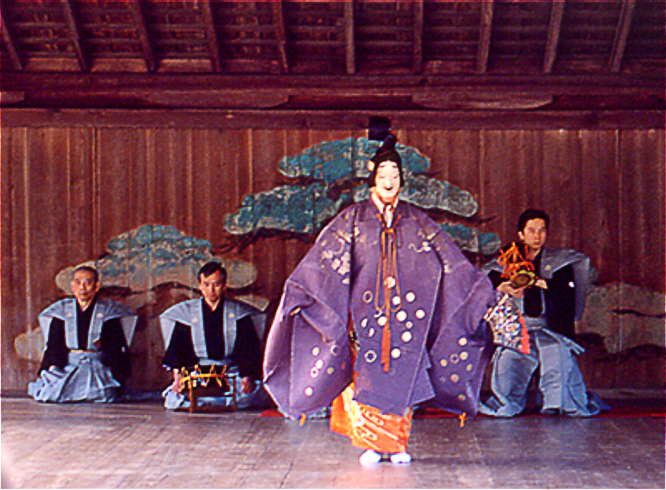
Public Domain, https://commons.wikimedia.org/w/index.php?curid=141159
In recent years, young traditional performing artists have been adapting their art forms to appeal to younger generations in modern times. They are finding new ways to present their traditional performances by incorporating contemporary elements. This approach is helping to preserve and promote traditional performing arts while attracting a younger and broader audience.
For example, "にほんごであそぼう" is a popular Japanese children's television program that aims to teach young viewers the Japanese language and culture in a fun and engaging way. The program introduces children to various aspects of Japanese culture, such as 歌舞伎and 狂言. By combining language learning with cultural education, the show helps young viewers develop a deeper understanding and appreciation of the Japanese language and culture.
Another successful example is a theatrical adaptation of the popular 漫画 (まんが) and アニメ『鬼滅の刃』(きめつのやいば: Demon Slayer) in the style of 狂言 in a theater. It has attracted many audiences who don't usually attend traditional performing arts events. This production has been a great success and has set a new standard for the fusion of modern and traditional Japanese culture in the performing arts.
Sports
The sports culture in Japan runs deep and significantly impacts various aspects of Japanese life, reflecting values that are highly regarded in society. In Japan, there are traditional martial arts,武道 (ぶどう) and modern sports, and the difference between them lies in their historical background and purpose.
武道 developed as a means for 武士階級(ぶしかいきゅうthe samurai class)to acquire combat skills. 武道 such as 柔道 (じゅうどう) and 剣道 (けんどう) are based on 武士道精神(ぶしどうせいしん:the samurai spirit) and 禅(ぜん:Zen philosophy.) 武道 emphasize not only physical training but also mental training.These martial arts emphasize discipline, respect, and self-defense and have been practiced for centuries.
From a young age, children in Japan are encouraged to participate in sports activities to promote discipline, teamwork, and physical fitness. 文武両道(ぶんぶりょうどう) is a Japanese concept that promotes the idea of balancing academic education with martial arts training. The term "文" refers to literary pursuits, while "武" refers to martial pursuits. Together, they represent the idea of pursuing academic and physical excellence to achieve a well-rounded education and personal development. Japanese school education reflects this idea 文武両道. 体育(たいいく:Physical education) is offered for every student and an essential part of the curriculum in Japanese schools, from elementary to high school. Additionally, some schools offer martial arts classes, such as 剣道 or 柔道, as a way to promote physical fitness and character development.
One of the most popular modern sports in Japan is 野球(やきゅう:baseball) which was introduced to the country in the late 19th century by American missionaries. Today, baseball is a major sport in Japan, with its own professional league, the Nippon Professional Baseball (NPB), consisting of 12 teams. The popularity of baseball has also led to the development of high school teams, which compete fiercely in tournaments,選抜高校野球(せんばこうこうやきゅう)
選抜高校野球 also known as 甲子園(こうしえん)is deeply ingrained in Japanese culture, and it is not just a sporting event but also a cultural phenomenon that reflects many aspects of Japanese society and values One important aspect of 選抜高校野球 is the emphasis on teamwork and perseverance. Japanese culture places great importance on group harmony, and 選抜高校野球 provides an opportunity for high school students to learn how to work together to achieve a common goal. Another important aspect of 選抜高校野球 is its role in promoting community and pride in one's hometown. High schools participating in 選抜高校野球 are often seen as representatives of their respective prefectures, and the entire community rallies behind them to support them. Many local businesses and organizations offer their support to the teams, and fans travel from all over Japan to attend the games.
Nutrition and Food Culture
Japanese people have long cherished and respected nature, providing abundance daily. They feel the presence of 神 in 自然 and pray for good harvests and abundant fishing, expressing their喜び(よろこび: joy) and 感謝(かんしゃ:gratitude) for the harvest through seasonalお祭り(: festivals). These festivals are deeply rooted in various regions, with people carrying 神輿(みこしportable shrines),pulling 山車(だし:floats), playing music, and dancing to celebrate lavishly. Thus, the Japanese food culture has evolved, emphasizing the importance of expressing gratitude for the natural bounty that sustains them.
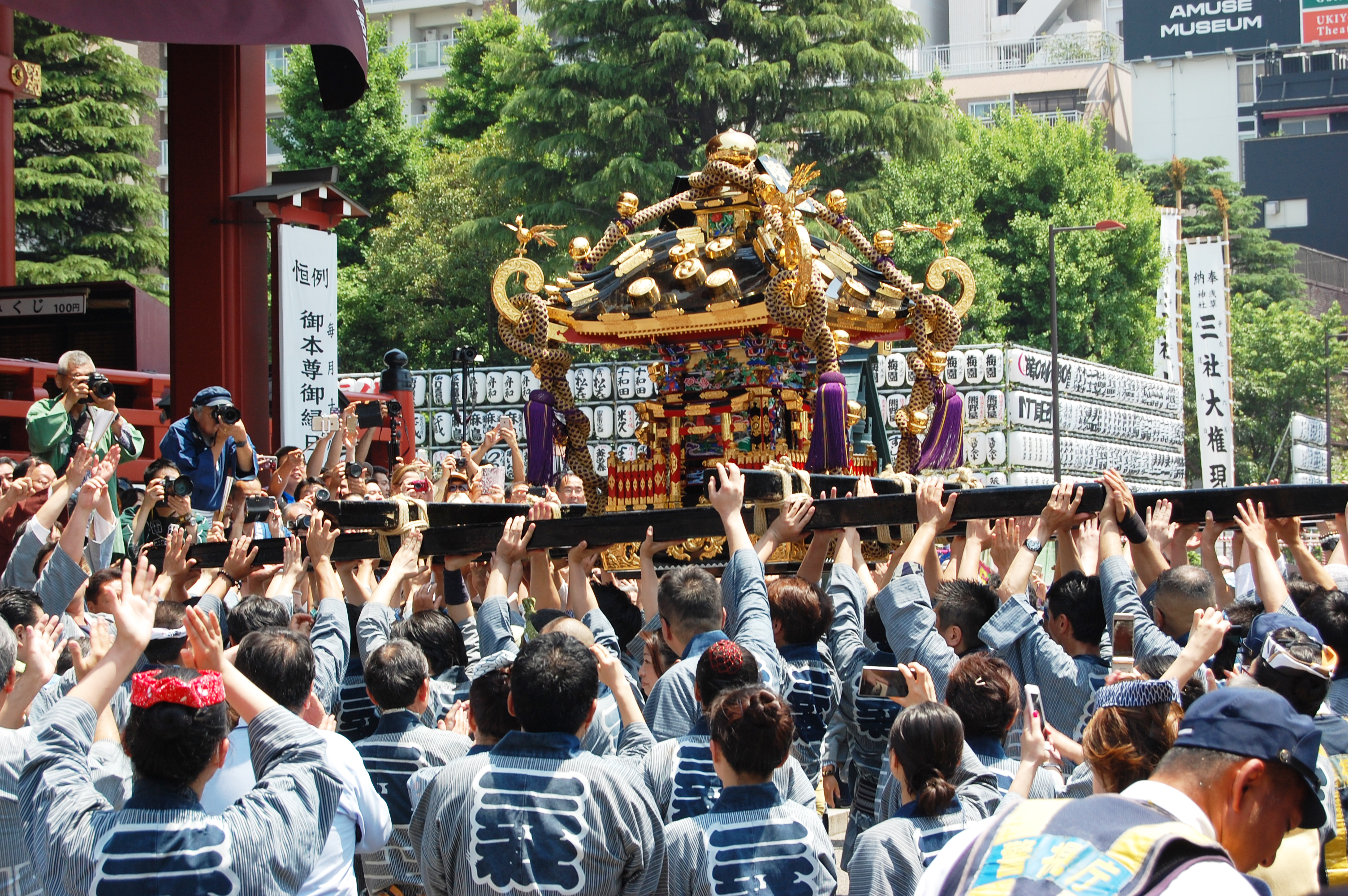
https://free-materials.com/お神輿の「差し上げ」01/
Japan, which is long in the north-south direction and has four clear seasons, has diverse and abundant nature. The food culture born there has also been nurtured to accompany this nature closely. Based on the Japanese temperament of "respecting nature," the "customs" related to "food" have been registered as "和食(; traditional Japanese food culture)" in the UNESCO Intangible Cultural Heritage in 2013.
Here are four distinguishing characteristics of "和食"
Respect for diverse and fresh ingredients and their characteristics.
Japan's diverse terrain stretches from north to south and includes a rich and varied natural landscape, ranging from the sea to the mountains and countryside. As a result, each region of Japan has its own distinct culinary culture and regional specialties that utilize locally-sourced ingredients. This unique culinary heritage is known as 郷土料理 (きょうどりょうり)
郷土料理 is characterized by the use of local and seasonal ingredients and unique cooking techniques and flavor combinations that have been passed down through generations. Each region has its signature dishes and ingredients specific to the area.
Some examples of 郷土料理 are as follows:
- 北海道(ほっかいどう):ジンギスカン - a grilled lamb dish named after Genghis Khan, served with vegetables and usually cooked on a domed skillet.
- 沖縄(おきなわ):ゴーヤチャンプルー - a stir-fry dish featuring bitter melon (goya), tofu, pork, and vegetables, and seasoned with soy sauce.
- 京都(きょうと):懐石料理(かいせきりょうり)- a multi-course meal that features seasonal and local ingredients, beautifully presented and carefully arranged on the plate.
- 広島(ひろしま):お好み焼き(おこのみやき) - a savory pancake made with a variety of ingredients such as cabbage, pork, seafood, noodles, and topped with sauces and mayonnaise.
- 大阪(おおさか): たこ焼き(たこやき)- tiny balls of batter filled with pieces of octopus, tempura scraps, and green onion, often served with a savory sauce and mayonnaise.
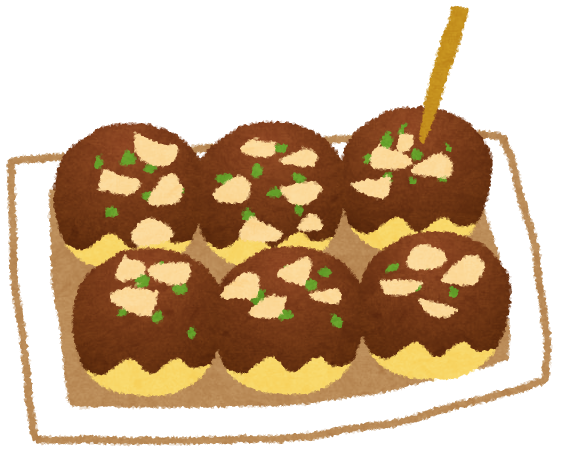
https://www.irasutoya.com/2012/03/blog-post_2655.html
Nutritional balance that supports a healthy diet The basic Japanese meal style of 一汁三菜(いちじゅうさんさい:one soup and three dishes) provides an ideal nutritional balance. By skillfully using うまみ (savory taste), Japanese cuisine realizes a low-fat diet, contributing to the longevity and prevention of obesity among the Japanese.
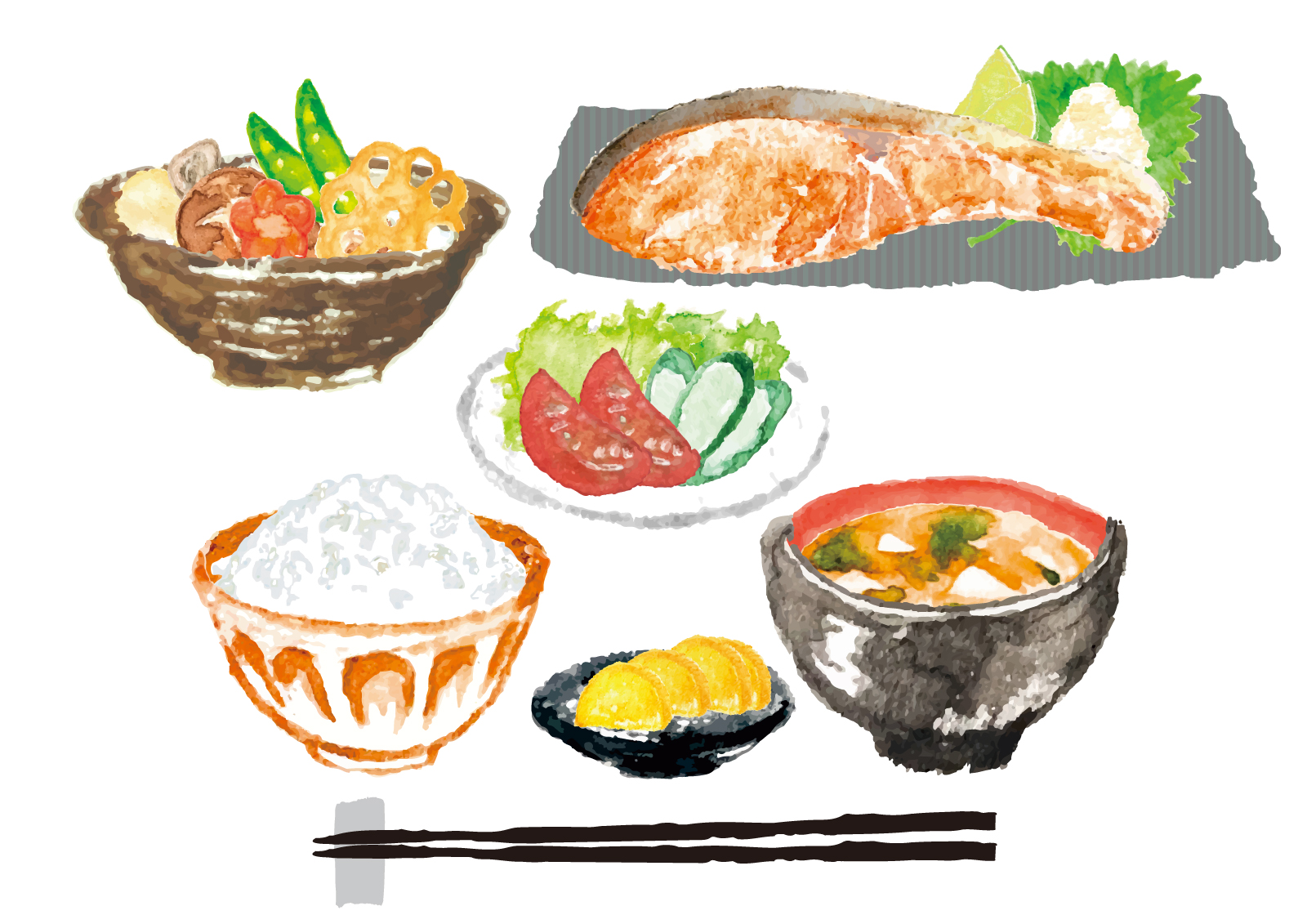
https://creator.pixta.jp/@unitsukkomi
Expression of the beauty of nature and the changing seasons
Another characteristic of Japanese cuisine is the expression of the beauty of nature and the changing seasons in the dining experience. Decorating dishes with seasonal flowers and leaves, and using seasonal furnishings and tableware, allows for the enjoyment of seasonality.
Close relationship with year-round events such as New Years Japanese food culture has been closely linked with year-round events. Japanese families and communities have deepened their bonds by sharing the blessings of nature in the form of food and spending meal times together.
New Year's cuisine in Japan is a time-honored tradition that celebrates the start of a new year with delicious and auspicious dishes that bring good luck and prosperity.
One traditional dish is おせち料理 (おせちりょうり), which is a set of colorful and beautifully arranged dishes that are prepared in advance and enjoyed during the first three days of the new year.おせち料理 typically includes a variety of dishes that symbolize good luck, health, and prosperity for the coming year. For example, 伊達巻 (だてまき), which is a sweet rolled omelet, represents knowledge and scholarship, while 黒豆 (くろまめ), which is black soybeans cooked with sugar and soy sauce, symbolizes health and hard work. Other common dishes include 煮しめ (にしめ), a stewed dish made with vegetables and seafood, and 紅白なます (こうはくなます), which is a pickled dish of white radish and carrot.
Another popular dish during the new year is お雑煮 (おぞうに), which is a soup made with もち and various ingredients such as chicken, seafood, and vegetables. The ingredients vary by region, and each family has its own recipe and way of making the soup.
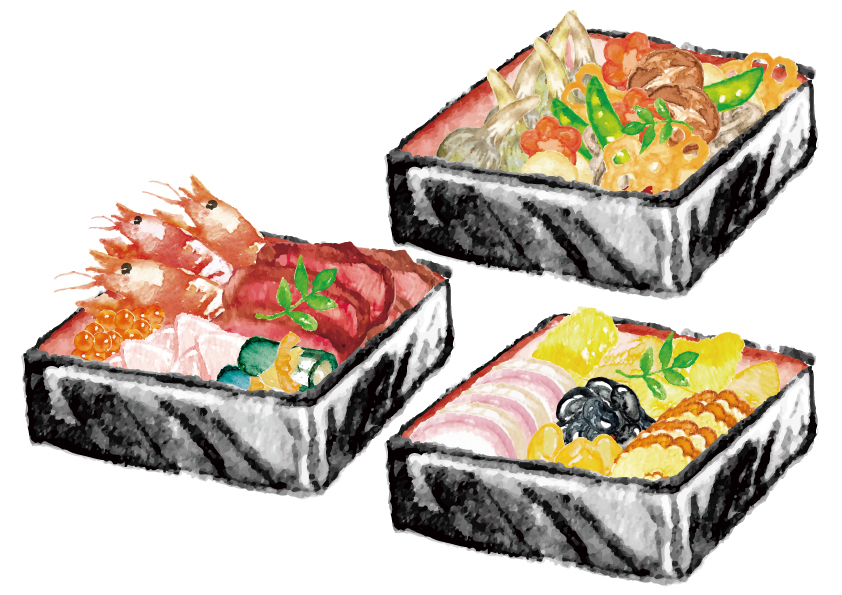
おせち料理(おせちりょうり): New Year's meal
https://creator.pixta.jp/@unitsukkomi
節分 (せつぶん) is another traditional seasonal event in Japan. This 節分 tradition is called 豆まき(まめまき), where family and friends scatter roasted soybeans, 福豆 (ふくまめ), around the house and then throwing them out the door or window while shouting 「鬼は外、福は内」 (おにわそと、ふくわうち) which means "demons out, good luck in." This tradition is believed to drive away evil spirits and brings health and good luck for the coming year. In addition, during 節分, people eat the same number of beans as their age. Eating beans according to age is thought to bring good health for the following year. In addition to eating beans, there are other food traditions on the night of 節分. People eat a special sushi roll called 恵方巻き (えほうまき). This sushi roll is usually made with seven ingredients that are believed to bring good luck for the coming year, such as tuna, salmon roe, and cucumber. It is important to eat the entire roll in complete silence while facing a particular direction, which changes yearly based n the Chinese zodiac.
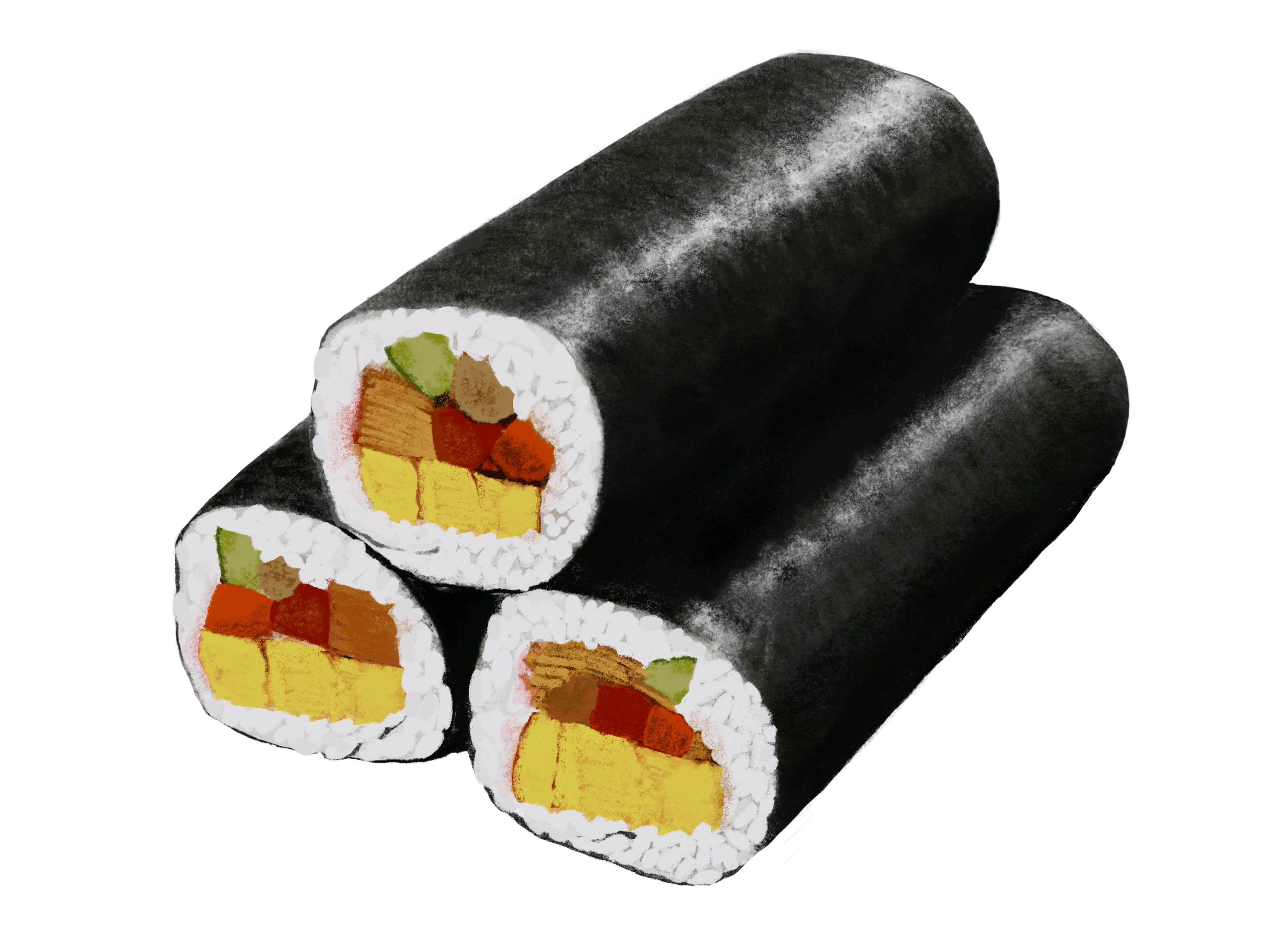
https://www.ac-illust.com/main/detail.php?id=23447744&word=恵方巻き(皿なし)&data_type=&from_order_history=#
Browse Study Guides By Unit
👨👩👧Unit 1 – Families in Japan
🗣Unit 2 – Language & Culture in Japan
🎨Unit 3 – Beauty & Art in Japan
🔬Unit 4 – Science & Technology in Japan
🏠Unit 5 – Quality of Life in Japan
💸Unit 6 – Challenges in Japan
🧐Exam Skills
📚Study Tools

Fiveable
Resources
© 2025 Fiveable Inc. All rights reserved.